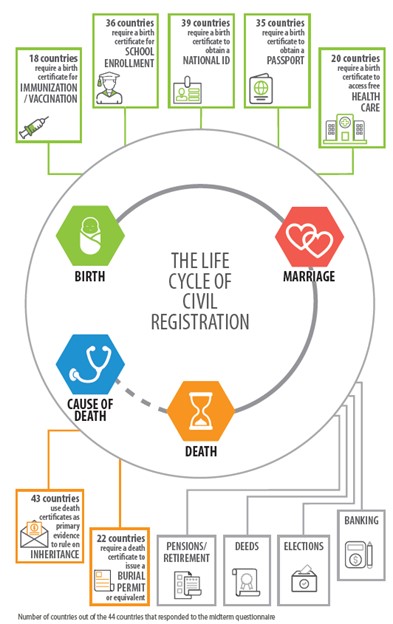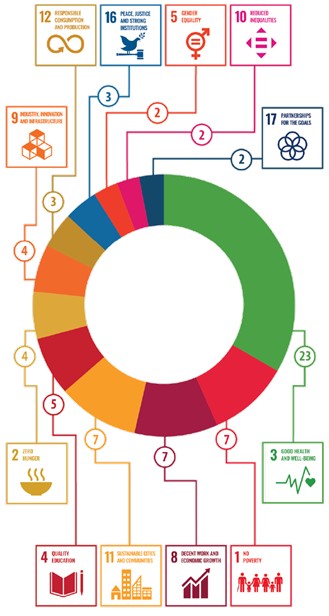Date: 22/03/2024
Author: Alice Wolfle

Bio:
Alice Wolfle is an ESRC, SCDTP funded PhD Candidate in the Department for Social Statistics at the University of Southampton. Her research relates to understanding how seasonality impacts health and nutrition in low- and middle-income countries. Alice has recently completed an SCDTP-funded internship at the United Nations Economic and Social Commission for Asia and the Pacific in the Statistics Division, focusing on Civil Registration and Vital Statistics.
In the world of quantitative research, where demographic data serves as the backbone for research and policy interventions, civil registration systems play a crucial role. Civil registration and vital statistics (CRVS) systems are responsible for documenting every birth and death in a country and are compiled to produce vital statistics that help us understand population dynamics. However, globally, 1 in 4 births of children under the age of 5 are not yet registered, while 40% of deaths remain unregistered (ESCAP, 2021).

Figure 1: The life cycle of civil registration: a summary of the state of CRVS systems in Asia and the Pacific. (Source: ESCAP, 2021)
From a statistician’s perspective, incomplete civil registration is an issue for many reasons. For example, if a death is not registered, a cause of death cannot be recorded. In an era of a global pandemic, COVID-19 has highlighted the importance of measuring the cause of death more than ever. Measuring the cause of death is also essential for understanding public health issues, such as addressing reductions in air pollution or road-traffic related deaths. If we do not have access to accurate and timely birth and death rates, this can impact the calculation of population projections, and the effectiveness of government policy that depends on such data.
While good quality data is essential from the perspective of a statistician, at the individual level, it is also critical to ensure that every person has every vital event registered as a basic human right to ensure a legally recognized identity. If a child does not have a birth certificate, the child can often not enrol in school, access health care, or be legally adopted. If someone is not registered at birth, they cannot obtain a passport, or access social protection programs such as pension or even open a bank account (see Figure 1). A birth certificate is also essential for political participation, one cannot vote if their identity is not legally recognized. If a marriage is not registered, a child is at risk of being married under the legal age. The implications of not being registered are worse for women and, with approximately 50% of women in low-income countries unable to prove their legal identity (ESCAP, 2021).
According to Vital Strategies, in more than 100 low- and middle- income countries, CRVS systems are not fully functioning. Ineffective CRVS systems may be due to a lack of coordination between government agencies and healthcare providers, outdated technical infrastructure, sparse provision of registration offices and lack of staffing or complex legal frameworks creating hurdles for timely registration. In many countries paper-based CRVS systems remain, which are a highly inefficient use of human resources due to information being copied manually (by hand) and prone to data entry errors that are hard to change later. Additionally, paper registration records prevent linkages to other public information databases, delay the compilation and production of vital statistics and are at risk of irretrievable loss or damage in the case of a natural disaster.
The process of registering a vital event can feel like a bureaucratic labyrinth, a contributing factor to why universal civil registration has not yet been achieved. Barriers may relate to families being unable to travel to a registration office due to financial or geographical constraints, particularly when the registration process requires multiple trips! Family members may also be required to present a recognized form of identification, which may not be possible if they were not registered or were unable to obtain a recognized copy of the document. A key reason for an unregistered vital event is a lack of awareness of the requirements and relevance of registering the event. These barriers mean that marginalized and hard-to-reach populations are disproportionately less likely to be registered, placing an individual and their families at a disadvantage throughout their life course.

Figure 2: Number of indicators benefiting from civil registration and vital statistics data in the 2030 Agenda. (Source: ESCAP, 2021; Mills et al., 2017)
The United Nations Economic and Social Commission for Asia and the Pacific (ESCAP), have played a vital role in strengthening CRVS systems in Asia and the Pacific, to get every one in the picture! ESCAP’s Statistics Division provide technical support to countries and CRVS stakeholders in Asia and the Pacific to make CRVS systems more inclusive and resilient. This includes two key activities, inequality assessments and CRVS systems improvement which are outlined below.
If we know that not everyone is registered, how is it possible to know who is not registered? Inequality assessments analyze secondary data to identify which population subgroups are least likely to be registered, so that interventions to increase registration rates may be targeted towards these populations. Inequality assessments have recently been conducted in Fiji and Lao PDR, finding that women and indigenous and rural populations have lower registration rates.
In order to remove as many barriers as possible in the complex and cumbersome CRVS system, ESCAP has supported countries in streamlining the process of registering a vital event, improving the user experience, and compiling this data to produce timely vital statistics reports. A CRVS improvement framework has been developed as a tool for assessing current registration processes, analyzing where bottlenecks occur, and re-designing the processes to reduce the number of barriers. Business process improvement projects have recently been completed in Maldives and Niue (a Small Pacific Island state). The mapping provides the foundation for implementing or improving a digitized CRVS system and ensure linkages between health facilities and the registration authorities to make registering an event easier for families.
My recent internship experience at ESCAP has highlighted the number of Sustainable Development Goal (SDG) indicators that benefit from CRVS data for the 2030 Agenda (see Figure 2). Civil Registration also has a dedicated target (16.9) in the 2030 SDG Agenda, to provide legal identity for all, including birth registration by 2030.
As we continue to rely on demographic data for informed decision-making, it is important to invest in the underlying systems providing this data. We must continue to raise awareness for the importance of universal civil registration and ensure that everyone really is in the picture.
To read a blog post that I wrote during my internship at ESCAP: https://www.unescap.org/blog/bureaucratic-labyrinths-accessible-civil-registration
To sign up for the insightful monthly CRVS newsletter: https://getinthepicture.org/subscribe-our-newsletter
To view future internship opportunities with ESCAP: https://www.unescap.org/jobs/internships
References
ESCAP. (2021). Getting every one in the picture: A snapshot of progress midway through the Asian and Pacific civil registration and vital statistics decade. United Nations. https://repository.unescap.org/handle/20.500.12870/4701
Mills, S., Abouzahr, C., Kim, J., Rassekh, B. M., & Sarpong, D. (2017). Civil registration and vital statistics for monitoring the sustainable development goals. World Bank. https://openknowledge.worldbank.org/handle/10986/27533